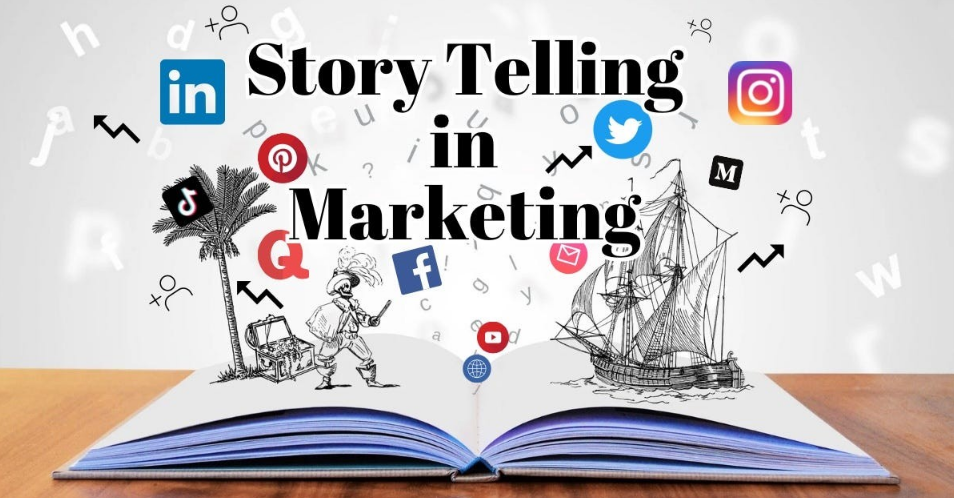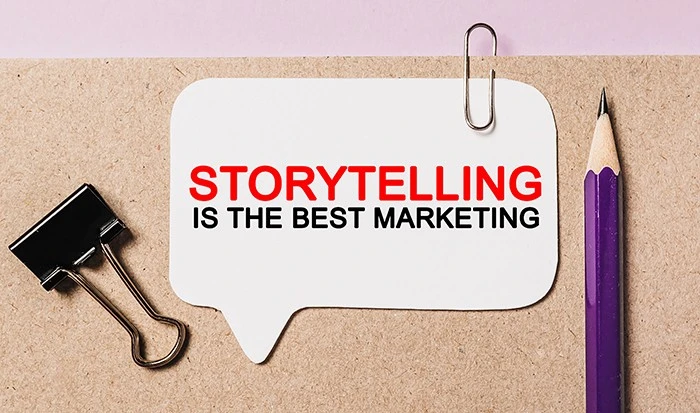As we step into 2024, marketing is evolving rapidly due to changing customer expectations. There was a time when posting content and fancy images was enough for marketers. However, things have changed, and you need to connect with the audience through storytelling in marketing.

That is where storytelling comes into the picture, a powerful tool for the experts to engage with the audience, build connections and boost their sales.
Table of contents
What is Storytelling in Marketing?
Storytelling in marketing involves creating a narrative that resonates with your audience, conveying your brand’s values, mission, and vision. Unlike traditional advertising, which focuses on selling, storytelling aims to engage, entertain, and inspire.

In addition, it enhances your SEO efforts by increasing your brand visibility and credibility. In this article we will explain why you need to use storytelling as a weapon to attract more audience and increase your ROI.
Benefits of Storytelling
Humans are wired to respond to stories. From ancient myths to modern movies, stories have the power to capture attention and evoke emotions. This psychological aspect makes storytelling a powerful tool in marketing, as it can influence consumer behavior and decision-making.
Building Emotional Connections
Storytelling helps in building emotional connections with your audience. When people relate to your brand’s story, they are more likely to develop a sense of loyalty and trust. Emotional connections drive customer retention and advocacy.
Enhancing Brand Identity
A well-crafted story can enhance your brand identity by highlighting your unique value proposition. It differentiates you from competitors and positions your brand in the minds of consumers as something more than just a product or service.
Creating Memorable Content
Memorable content is key to a successful marketing strategy. Stories are inherently memorable because they are structured in a way that our brains find easy to recall. By integrating storytelling into your content, you ensure that your brand stays top-of-mind.
Improving Customer Engagement
Engaging content is crucial for keeping your audience interested. Storytelling encourages active participation and interaction. Whether through comments, shares, or likes, storytelling can significantly boost engagement metrics.
Driving Social Media Success
Social media platforms thrive on stories. From Instagram Stories to Facebook posts, narrative-driven content performs better because it captures attention and encourages sharing. This amplifies your brand’s reach and impact.
Boosting SEO through Storytelling
Storytelling enhances your SEO efforts by Engaging content that reduces bounce rates and increases dwell time. which are positive signals for search engines. Additionally, compelling stories are more likely to attract backlinks, further boosting your SEO efforts.
Storytelling Formats to Consider
There are various formats you can use for storytelling, below are the following for a better understanding
- Blog Posts: Long-form content that allows for in-depth storytelling.
- Videos: Visual stories that can convey emotions effectively.
- Social Media Posts: Short, engaging stories tailored for quick consumption.
- Podcasts: Audio stories that engage listeners on-the-go.
Tips for Effective Storytelling

| Tips for Effective Storytelling | Explanation |
| Know Your Audience | Understanding your audience’s needs, preferences, and pain points helps you craft a story that resonates. Tailoring your narrative to their interests makes it more engaging and relatable. This connection fosters a deeper bond with your audience. |
| Be Authentic | Authenticity is key to building trust with your audience. Genuine stories that reflect your true values and experiences resonate more deeply. Authenticity fosters trust and loyalty, making your brand more relatable. |
| Keep it Simple | Avoid overly complex narratives that might confuse your audience. A straightforward and clear story is easier to follow and more impactful. Simplicity ensures your message is understood and remembered. |
| Incorporate Visuals | Enhance your storytelling with images, videos, and infographics. Visual elements capture attention and make your story more engaging. They help illustrate your points and make the narrative more memorable. |
Measuring the Impact of Storytelling
To measure the effectiveness of your storytelling efforts, track metrics such as engagement rates, conversion rates, and brand sentiment. Use tools like Google Analytics and social media insights to gather data and refine your strategy.

Conclusion
In 2024, storytelling will be more critical than ever for marketing success. By leveraging the power of narratives, brands can create deeper connections, enhance their identity, and drive better engagement and conversions. Start integrating storytelling into your marketing strategy today and witness the transformative impact it can have.
Read more: Innovative Digital Marketing Campaigns: Inspiration for 2024
FAQs
Storytelling helps build emotional connections with the audience, enhancing brand identity and engagement.
Engaging stories reduce bounce rates and increase dwell time, which are positive signals for search engines, and they attract backlinks.
Storytelling can be done through blog posts, videos, social media posts, and podcasts.
Emotional connections drive customer loyalty and trust, leading to better retention and advocacy.


